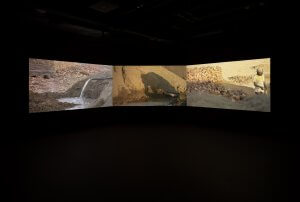Ali Cherri: Humble and quiet and soothing as mud | New York Times
Dec 01 2023

What to See in N.Y.C. Galleries in December
On the second floor of Ali Cherri’s exhibition “Humble and Quiet and Soothing as Mud,” there is a video projected onto three screens. Titled “Of Men and Gods and Mud” (2022), it shows laborers fashioning mud into bricks who toil in the shadow of the Merowe Dam in northern Sudan, the construction of which displaced about 50,000 people and caused significant social and environmental upheaval.
Women’s voices (one speaking English, one Arabic) narrate: “Somewhere, by the banks of a great river, on the banks of a gargantuan dam, a man stands waist deep in mud. …” The language seems less documentary than mythic, akin to the many creation stories (Sumerian, Abrahamic, Maori, Hindu, Yoruba) in which the material plays a central role. The effect is to telescope time, so that contemporary geopolitical and environmental catastrophes are read against primeval creation and destruction — perhaps, the Lebanese-born Cherri suggests, we are living in another antediluvian moment, just before the dam breaks.
Mud — as material and symbol — is also explored in four sculptures on the ground floor related to the ancient Sumerian hero Gilgamesh and the molding of his companion, Enkidu, who was molded from clay. Despite their seeming fragility, these figures cast fierce-looking shadows on the walls. Standing in for their faces are archaeological relics — from Egypt, Mali, the Kongo kingdom, France — that the artist bought from auctions, their prices reflecting current monetary and cultural valuations. In Cherri’s work, past and present are never separate or even distant — a gently devastating argument against the idea that as a species, we’ve progressed.
